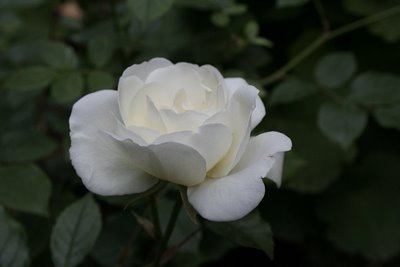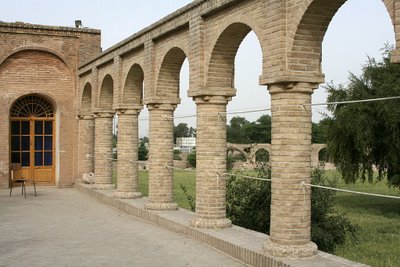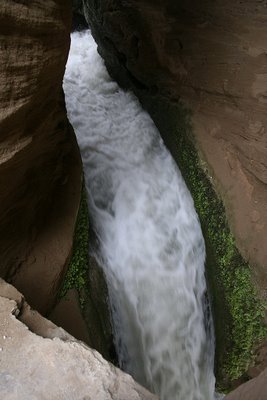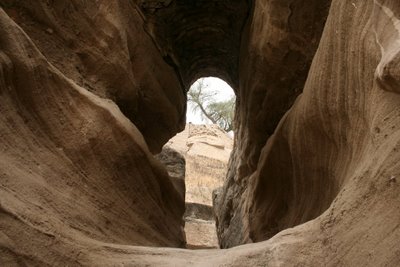 One of our white roses.
One of our white roses. 
 The open terrace of the historic Mostofi House with the picturesque view of Shadorvan (from my previous post).
The open terrace of the historic Mostofi House with the picturesque view of Shadorvan (from my previous post). 
 Shadorvan is a bridge and barrage in north of Shushtar. It spans Shoteit (a branch of the greater Karun). It is believed to be a Sassanid bridge but it has been rebuilt and restored more than several times during its long life. Several bays of the 500 meter collapsed during the last 150 years.
Shadorvan is a bridge and barrage in north of Shushtar. It spans Shoteit (a branch of the greater Karun). It is believed to be a Sassanid bridge but it has been rebuilt and restored more than several times during its long life. Several bays of the 500 meter collapsed during the last 150 years.
 A view of one the water wells which directs water to the watermill about 2.5 meters lower. There are about 30 water wells like this in the complex in the previous post. Its really amazing when you stand so close (even much closer than what you see here) to water falling down with great power and sound.
A view of one the water wells which directs water to the watermill about 2.5 meters lower. There are about 30 water wells like this in the complex in the previous post. Its really amazing when you stand so close (even much closer than what you see here) to water falling down with great power and sound. 
 A panoramic view of the watermills complex. I have posted a few pictures of the watermills here in February 2006. The watermills are a part of a huge water supply plan in north of Khuzestan State on the river of Karun which was started in Achamenian era (circa 600 BC) and vastly developed in Sassanid era (224-651 AD). Shushtar is very close to Shush (also written as Susa by French archeologists)the capital of Elamites (circa 5500-1000 BC). Therefore we are looking forward to finding Elamite traces near the water structures. Some historians say that when Shapur the Great, the Sassanid emprore, captivated Valerianus, the Roman emprore, with about 70000 of the Roman army in Edessa war, he used their skill in rebuilding the bridges, barrages, and water canals in Shushtar. I have posted a picture of a relief showing the story of Shapur and Valerianus before (here) but as far as I know the story of Valerianus being in Shushtar is not scientifically accepted yet.
A panoramic view of the watermills complex. I have posted a few pictures of the watermills here in February 2006. The watermills are a part of a huge water supply plan in north of Khuzestan State on the river of Karun which was started in Achamenian era (circa 600 BC) and vastly developed in Sassanid era (224-651 AD). Shushtar is very close to Shush (also written as Susa by French archeologists)the capital of Elamites (circa 5500-1000 BC). Therefore we are looking forward to finding Elamite traces near the water structures. Some historians say that when Shapur the Great, the Sassanid emprore, captivated Valerianus, the Roman emprore, with about 70000 of the Roman army in Edessa war, he used their skill in rebuilding the bridges, barrages, and water canals in Shushtar. I have posted a picture of a relief showing the story of Shapur and Valerianus before (here) but as far as I know the story of Valerianus being in Shushtar is not scientifically accepted yet. 
 This is the effect of water movement inside a huge sandstone rock which was dug by man for constructing a complex of water-mills several centuries ago. The original water-mills don't exist anymore (alas) but the tunnels and canals are still there. They create very picturesque views. I'll post more of these historic water structures in Shushtar.
This is the effect of water movement inside a huge sandstone rock which was dug by man for constructing a complex of water-mills several centuries ago. The original water-mills don't exist anymore (alas) but the tunnels and canals are still there. They create very picturesque views. I'll post more of these historic water structures in Shushtar. 
 I found lots of this flower in my recent trip to Shushtar in south of Iran. I still don't know its name in English. The only thing I know is that its wild type is Verbena. In Persian we call it Shah-Passand which means delightful for the king!
I found lots of this flower in my recent trip to Shushtar in south of Iran. I still don't know its name in English. The only thing I know is that its wild type is Verbena. In Persian we call it Shah-Passand which means delightful for the king! 
 Sanctuary of Uljaitu is an early 14th century addition to Jameh-Mosque of Isfahan. I have posted a few pictures of the mosque before. The sanctuary is perhaps the most famous one of its type.
Sanctuary of Uljaitu is an early 14th century addition to Jameh-Mosque of Isfahan. I have posted a few pictures of the mosque before. The sanctuary is perhaps the most famous one of its type. 
 This is a detail of one of the subtle plaster altars of the mosque. I am not aure abut when it was built but I guess it should be in the 14th or 15th.
This is a detail of one of the subtle plaster altars of the mosque. I am not aure abut when it was built but I guess it should be in the 14th or 15th. 
 While I was in a historical site in Shushtar, discussing with colleagues on the most appropriate ways to take care of it, I mentioned this colorful beautiful worm. I wonder what's its name!
While I was in a historical site in Shushtar, discussing with colleagues on the most appropriate ways to take care of it, I mentioned this colorful beautiful worm. I wonder what's its name! 
 Yesterday I was in Shushtar, a city in southern Iran. I saw a very young shepherd with his goats and sheep. I think he was from the Bakhtiari tribes who live in northern Shushtar. Bakhtiari people belong to an ancient civilization who have lived in Zagros mountains for several milleniums.
Yesterday I was in Shushtar, a city in southern Iran. I saw a very young shepherd with his goats and sheep. I think he was from the Bakhtiari tribes who live in northern Shushtar. Bakhtiari people belong to an ancient civilization who have lived in Zagros mountains for several milleniums. 